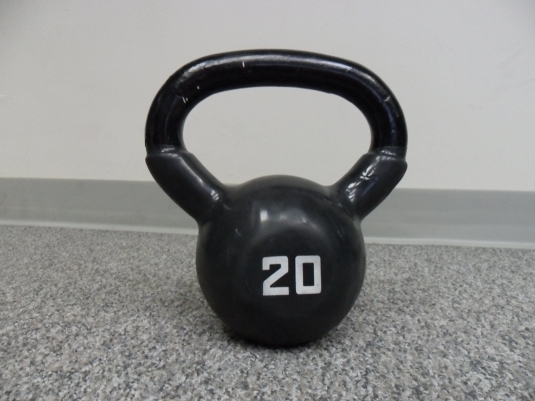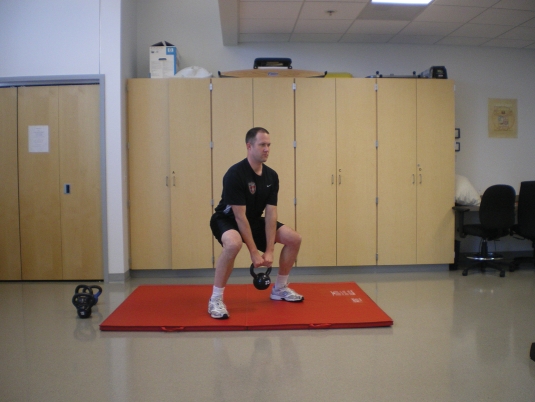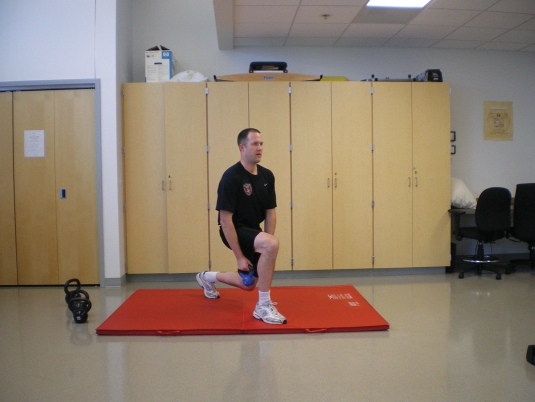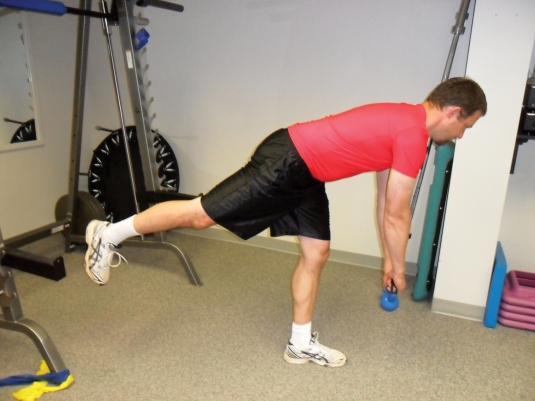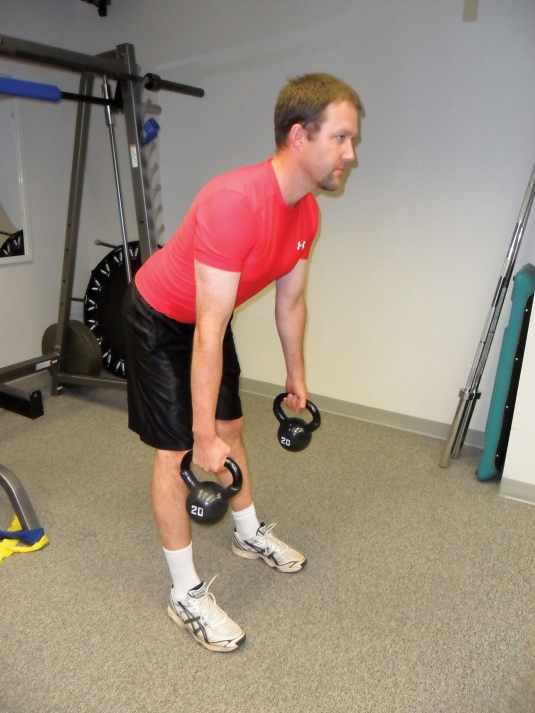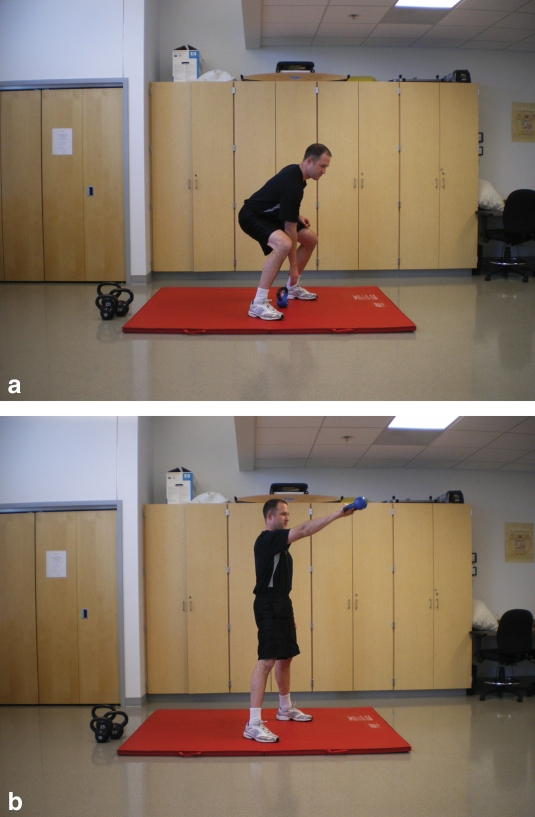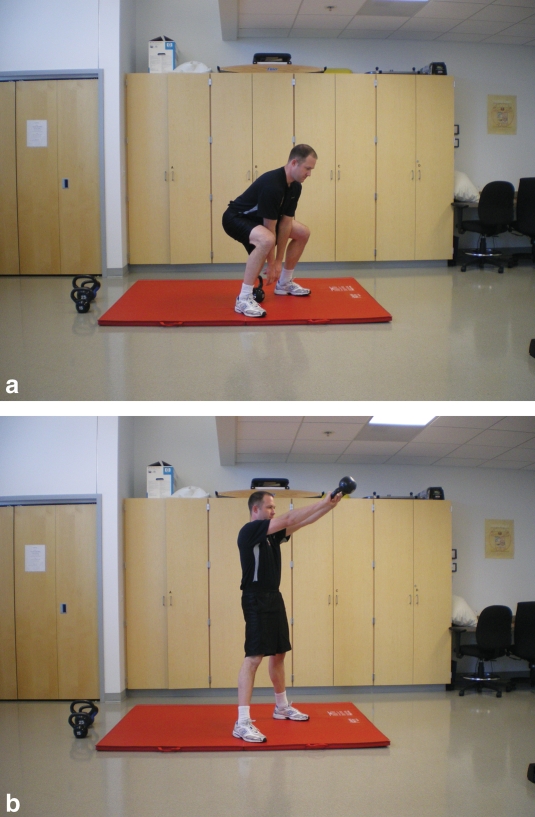Abstract
The primary goal of a sports rehabilitation program is to return the injured athlete back to competition as quickly and as safely as possible. Sports physical therapists utilize a variety of exercise equipment to help an athlete restore function after an injury. An injured athlete's therapeutic exercise program frequently includes the prescription of functional strengthening and power exercises during the later stages of rehabilitation. One piece of exercise equipment, the kettlebell, has gained popularity for its ability to allow the user to perform functional power exercises. The unique exercises that can be performed with kettlebells may have utility in sports physical therapy practice. This clinical suggestion outlines the clinical rationale for the inclusion of kettlebell exercises when rehabilitating an athlete with a lower extremity injury.
Keywords: inertia, kettlebells, power training, therapeutic exercise
INTRODUCTION
The primary goal of a sports rehabilitation program is to return the injured athlete back to competition as quickly and as safely as possible. One component of an athlete's comprehensive therapy program is the prescription of therapeutic exercises designed to restore and/or increase range of motion (ROM), strength, and power. Sports medicine professionals utilize a variety of exercise equipment when rehabilitating athletes with lower extremity injuries. Traditional resistance training tools (e.g. elastic bands, dumbbells, machines, etc) are often prescribed for use during exercise by physical therapists and other sports rehabilitation professionals to enable patients to begin strength training as early and as safely as possible after an injury.
Table 1 presents common types of exercise equipment that are utilized during each stage of rehabilitation. For example, an athlete recovering from knee surgery may be able to perform a leg press on a Total Gym™ or on a Shuttle™ (repetitions are performed at a percentage of total body weight) prior to performing the leg press on a traditional isotonic resistance machine. During the course of an athlete's recovery, exercises that reproduce functional (or sport-specific) movement patterns should be prescribed. Including kettlebell (KB) specific exercises during later stages of rehabilitation may provide an appropriate training stimulus that would help prepare the athlete for the physiological requirements of sport.
Tabe 1.
Common Exercise Equipment Used during Phases of Rehabilitation.
| Phase of Healing | Timeframe and Treatment Goals | Exercise Strategy (and Equipment) |
|---|---|---|
| I. Acute Stage (Inflammatory Response) | 1 to 4 days | ROM and Muscular Flexibility Exercises Passive range of motion, gentle passive stretching(stretching bands, straps, pulleys, physioballs, slant boards, stretching machines) |
| Decrease pain | Resistance Training Isometric exercises (elastic bands, cushions, bolsters) | |
| Decrease swelling | ||
| Improve range of motion | ||
| II. Subacute Stage (Repair and Healing Phase) | 4 days to 1 month | ROM and Muscular Flexibility Exercises Passive range of motion → active range of motion, stretching (stretching bands, pulleys, physioballs, slant boards, stretching machines) |
| Decrease pain | Resistance Training Isometric exercises, muscular endurance training, and strength training (elastic bands, dumbbells, kettlebells, barbells, ankle weights, pulleys/cable machine, strength training machines, Total Gym™, Shuttle™, Fitter™) | |
| Increase range of motion | Balance (foam rolls, BOSU™, balance disks) | |
| Increase strength | ||
| Improve cardiovascular fitness | ||
| III. Chronic Stage (Maturation and Remodeling Phase) | 1 month to 1 year | Resistance Training Strength training, power training (elastic bands, dumbbells, kettlebells, barbells, pulleys/cable machine, strength training machines) |
| Increase strength | Agility Training (hurdles, cones, agility domes, ladders, agility poles, agility rings, slide boards) | |
| Restore functional movements | Stability (Body Blade™) | |
| Sport-specific training | Power Training (plyometric boxes, plyo balls, rebounder, barbells, kettlebells) |
Kettlebells
A KB is a cast-iron weight shaped like a ball with a handle (Figure 1). KBs are commercially available in weights ranging from 3-pounds to 100-pounds (or more).
Figure 1.
A 20 lb Kettlebell.
The use of KBs has been traced back to Russia in the early 1700s where their purpose was “as a counterweight for market produce scales”.1–3 At some point in time after their introduction in commerce, individuals began to lift and swing KBs for exercise.3 Until recently, training with KBs had been primarily performed by Russian athletes and military personnel.2,3 However, during the past several years the KB has emerged as a popular piece of training equipment in health and fitness settings.1,3
There are many potential clinical uses for the KB: strength training, dynamic flexibility exercises, and power training. Power is defined as time related to the performance of work (P 5 W/t). Work is defined as force generated over a distance (W 5 F 3 d). In other words if an athlete is powerful, he/she has the ability to move against resistance quickly and explosively. The ability to generate power is necessary in most sports. Athletes who play football, rugby, or wrestle require power to succeed during periods of player contact (e.g. play from the line of scrimmage, during a tackle, or when attempting to perform a take down). Athletes who participate in non-contact sports may also benefit from power training. For example, a golfer who must complete the swing of a club in a relatively short total swing time (accelerating the club through the arc of motion) may be able to drive the ball further than a competitor who is not able to swing the club as quickly.4 The KB may be used with a wide variety of traditional exercises; however, its unique shape allows individuals to develop power by performing the swinging exercises. Table 2 offers several examples of KB exercises, which will be discussed further throughout this clinical suggestion.
Table 2.
Example Kettlebell exercises.
| Exercise | Starting Position | Movement |
|---|---|---|
| Squats | ||
| Squat with 1 Kettlebell (Figure 4) | Instruct the athlete to grab a kettlebell handle with both hands. | A typical squat motion should be performed with the weight hanging between the legs. Note the proper position of the trunk and spine, do not allow trunk flexion. |
| Squat with 2 Kettlebells | Instruct the athlete to hold a kettlebell in each hand with the weights positioned by the shoulders, by flexing elbows. | A typical squat motion should be performed maintaining the position of the kettlebells against each shoulder. |
| One-Arm Overhead Kettlebell Squat | Instruct the athlete to grab a kettlebell in one hand, and hold it directly overhead. | The athlete performs a traditional squat holding a kettlebell in an arm extended directly overhead. Increases demands on the UE and core. **May progress to bilateral KB's held overhead to increase difficulty. |
| Lunges | ||
| Lunges Holding Kettlebells | Instruct the athlete to hold a kettlebell in each hand, elbows extended, KB's hanging down toward the floor. | The athlete performs a traditional lunge exercise, lunging forward alternating lunges between each leg, maintaining excellent trunk/spine posture. |
| Lunge with Kettlebell Pass Between the Lead Leg (Figure 5) | Instruct the athlete to hold a kettlebell in one hand. | As the athlete lunges forward with the right leg, instruct the athlete to pass the kettlebell from the right hand under the right leg to the left hand Repeat the passing motion on opposite side. Maintain excellent trunk/spine posture. |
| Eccentric Hamstring Exercises | ||
| Single-limb Deadlift (Also called an inverted hamstring exercise) (Figure 6) | Instruct the athlete to balance on one leg with the knee fully extended. | The athlete bends at the hip, not the back (maintaining a neutral spine), lowering the torso to a horizontal position. Both hands hold a kettlebell below the chest. The athlete should feel a stretch in the hamstring of the supporting leg. Return to the upright position. |
| Double-limb Deadlift (Figure 7) | Instruct the athlete to hold a kettlebell with both hands, slightly in front of the body. | Instruct the athlete to bend at the hips maintaining a neutral spine. The athlete should lower oneself, stopping at the point where the trunk is parallel with the floor or at the point where he/she begins to lose the neutral spine posture (whichever comes first). Return to the start position and repeat. |
| Kettlebell Swings | ||
| One-Arm Kettlebell Swing (Figures 2a & 2b) (Video 1, available at www.naispt.org) | Instruct the athlete to assume a squat position with one arm holding a kettlebell (overhand grip) between the legs. | The athlete assumes a power position (squat with feet slightly wider than hips and shoulders) with the kettlebell positioned between the legs. Instruct the athlete to grab the kettlebell with one hand and forcefully swing it to the height of one's head. Next, the athlete will allow the kettlebell to swing (lower) between the legs, just posterior to the body. The athlete then repeats the swing, quickly reversing the direction creating the power for the movement from the hips and legs. The movement should be smooth and controlled. |
| Two-Arm Kettlebell Swing (Figures 3a & 3b) (Video 2, available at www.naispt.org) | Same start position as One-Arm swing, except grasp the kettlebell with both hands. | This exercise is performed in the same manner as the one-arm kettlebell swing except that both hands are holding the kettlebell. |
Figure 4.
Squat with 1 KB, note proper trunk and spine position.
Figure 5.
Lunge with KB Pass between the legs.
Figure 6.
Single-limb Deadlift, note proper trunk and spine position.
Figure 7.
Double-limb Deadlift, note proper trunk and spine position.
For an athlete to develop power he/she must generate a force greater than that of inertia provided by an object at rest.5–8 If the force applied to an object (e.g. resting KB) is not greater than that of inertia, no movement will occur. Unlike traditional dumbbells, the kettlebell handle allows the athlete to swing the weight through a curvilinear arc of motion.
To initiate the swinging motion, the athlete must concentrically contract muscles to accelerate the KB from the starting position. Near the top of the swinging motion, the athlete must eccentrically decelerate the KB followed by eccentrically controlling the descent of the KB back to the starting point. Please view Video 1 and Video 2 for examples of correct performance of KB swings. Power may be developed by explosively swinging the KB for a desired number of repetitions. Increasing the weight of the KB will increase the inertia thus requiring the athlete to generate more force.
There is paucity in the literature regarding the use of KBs in rehabilitation or strength training. A review of the following databases Medline (from 1950-Sept 2010) and CINAHL (from 1982-Sept 2010) using the Medical Subject Heading “kettlebell” revealed only 1 citation.1 Much of the information available on the use of KBs is strictly anecdotal or opinion based. Farrar et al1 assessed the heart rate and VO2max of ten men (age 20.8 6 1.1 years) while performing a KB exercise routine. The subjects, 9 out of the 10 of who were new to KB training, were assessed during 2 training sessions. During the initial session the researchers assessed baseline maximal oxygen consumption during a treadmill test (Bruce protocol) and the subjects received instruction on how to perform a KB swing exercise.1 During the second session, conducted 2 to 7 days after the 1st session, the subjects performed the two-arm KB swing for 12 minutes holding a 16-kg KB.1 The training goal was to perform as many repetitions during the 12-minute period; however, subjects were allowed to exercise at their own pace.1 Throughout the 12-minute period, the researchers recorded the subject's expired gases and heart rate. The authors found that individuals who performed a 12-minute routine of a 2-arm swing exercise (with a 16-kg KB) demonstrated a significant challenge to their cardiovascular system.1 The subjects' average HR during exercise was 87% of the HR achieved during the treadmill test.1 The average VO2max during the kettlebell program was 65% of the VO2max achieved during the treadmill test.1 The authors suggested that the KB training program used in this study could be performed to increase VO2max. The authors made no attempt to assess the subjects for changes in flexibility, strength, or power related to the performance of KB exercise.
The purpose of this clinical suggestion is to provide a rationale for incorporating KB exercises into an athlete's lower extremity rehabilitation program and to describe flexibility, strength, and power exercises that can be performed using KBs.
CLINICAL REASONING: THE SELECTION OF EXERCISE EQUIPMENT
The following section outlines the clinical reasoning associated with exercise prescription during the different phases of tissue healing. As previously mentioned, the KB may be used to develop power (later stages). In addition, the KB may be used during earlier rehabilitative exercises designed to enhance muscular endurance capacity and strength in lieu of other forms of equipment (e.g. dumbbells, barbells).
Resistance Training in the Acute Phase
The general treatment goals during the first few days after an injury are to decrease pain, decrease swelling, and maintain and/or increase joint range of motion and muscular flexibility. Minimal, if any, resistance training is performed during this period. Prescribing exercises, other than isometrics, may delay healing of the injured region, causing further pain and swelling.9,10
Resistance Training in the Subacute Phase
The general treatment goals during the subacute phase are to decrease pain, increase joint range of motion and muscular flexibility, and to restore/increase strength. The selection of a particular exercise should be influenced by the patient's diagnosis, their clinical presentation, the functional demands of their sport, and/or post-surgical status. Training parameters early in this stage emphasize muscular endurance (each set performed for at least 15 repetitions) with low loads progressing to strength training parameters (sets of 4-6 repetitions) in the later portion of the stage.11,12 There are several reasons for the prescription of high repetition, low load exercises during the early portion of the subacute phase. First, the athlete's strength deficits may be addressed by prescribing open kinetic chain exercises that target a weak muscle(s) in isolation (e.g. a short arc quad exercise for a weak quadriceps muscle or a side-lying straight leg raise for a weak gluteus medius muscle). Performing low load exercises may help reduce the chance of damaging newly deposited collagen fibers or impair the angiogenesis (neovascularization) required for supplying blood to the injured region. Second, the initial strength gains and neuromuscular control that are achieved early in the phase will help to facilitate the athlete's ability to perform functional, multi-joint closed kinetic chain exercises later in the stage (e.g. squats, lunges).
A kettlebell may be used, instead of dumbbells or barbells, to perform some traditional exercises during the subacute phase. For example, the athlete may be able to squat or perform a lunge with one or two KB's.
The inclusion of dynamic (or eccentric) flexibility exercises may also be initiated during this phase. A growing body of evidence suggests that the performance of eccentric exercises may help to improve muscular flexibility and reduce the risk of injury (or re-injury).13–15 The single limb and double-limb deadlift exercises, two eccentric exercises that train the hamstrings, may be performed with kettlebells during this stage.
Resistance Training in the Chronic Phase
Strength and power training exercises are initiated and progressed as tolerated during this phase by increasing exercise intensity and specificity during sport-specific functional movement patterns. All sports require some combination of strength, speed, and power.5 Recall that strength is the ability to do work (lifting a weight) over a distance (the range required to do the lift) whereas power is ability to produce work over a short period of time. The power, or Olympic, lifts (e.g. cleans, snatch, jerk) are examples of techniques or movements that help facilitate an athlete's ability to generate force quickly.5,16 An athlete's ability to perform these lifts correctly may be affected by post-injury deficits and/or a general lack of experience with these types of exercises. Having the athlete perform KB swings may allow the athlete the ability to begin to increase power by utilizing exercises that incorporate functional acceleration and deceleration movements. KB swings may assist in the transition from functional strengthening exercises to the traditional power lifts using either KBs or traditional equipment such as a bar with weight.
The Kettlebell Swings
The shape of the KB allows for a unique exercise application: the ability to perform swinging movements. By grasping the KB handle with one or both hands, an individual is able to swing the weight through a large arc of motion. Performing a one-hand (Previously shown in Figures 2a & 2b; Video 1) or two-hand KB swing (Previously shown in Figures 3a & 3b; Video 2) may activate important muscles in the lower extremities, the core, and the upper body. During the concentric portion of the swing (from the squat position to the terminal swing/ upright position), the athlete must generate a force to overcome inertia in order to elevate the KB to the terminal extension position, while the musculature of the core offers stabilizing contractions. To begin a swinging motion, the athlete will squat and grasp a KB handle (overhand grip) with one or two hands. The KB should be positioned just slightly behind the legs (Figures 2a, 3a). To initiate the motion, that athlete should start to stand up while pulling the KB forward. Once the KB is at approximately the height of the knees, the KB is swung between the legs followed by immediately reversing direction, generating power from the hips and legs to swing the KB to approximately shoulder height (Figures 2b and 3b). The athlete should be taught to maintain a neutral spine, bracing the muscles of the torso. Prior to the terminal extension (upright position) of the swinging motion, the athlete must begin to activate some muscles eccentrically in order to decelerate the motion. The KB's center of mass creates a long lever arm during the swinging motion. When compared to exercises with a shorter lever arm, the muscles that eccentrically decelerate the swinging motion may be at a greater mechanical disadvantage and thus may require greater force production to complete a repetition. At terminal extension, the kettlebell is returned to the starting position assisted by gravity, controlled by eccentric muscle contractions of the extremity and core musculature.
Figure 2.
a: Start Position: 1 Hand Kettlebell Swing; b: End Position: 1 Hand Kettlebell Swing.
Figure 3.
a: Start Position: 2 Handed Kettlebell Swing b: End Position: 2 Handed Kettlebell Swing.
DISCUSSION/CONCLUSION
There are numerous potential applications of exercises with a KB. Early, simple resistance training exercises can be progressed to more demanding, functionally complex movements. Brumitt and Dale17 suggested incorporating exercises using kettlebells when rehabilitating injured golfers. For example, performing a vertical swing of the KB diagonally across the body (from an initial squat position to a fully extended position) mimics a golfer's backswing.
There may be many applications for the KB swings. Further research is necessary to identify the potential benefits associated with KB training. Surface or fine-wire electromyography studies would help to identify muscle activation levels during KB specific exercises. Performing pre-test/post-test experimental design research investigations would help to describe changes in power attributable to rehabilitative and conditioning training programs using KBs.
REFERENCES
- 1.Farrar RE, Mayhew JL, Koch AJ. Oxygen cost of kettlebell swings. J Strength Con Res. 2010;24(4):1034–1036 [DOI] [PubMed] [Google Scholar]
- 2.Tsatsouline P. Enter the Kettlebell! St. Paul, MN: Dragon Door Publications, Inc., 2006 [Google Scholar]
- 3.Fable S. Kettlebell comeback. IDEA Fitness J. 2010; 7(2):25–27 [Google Scholar]
- 4.Meira EP, Brumitt J. Minimizing injuries and enhancing performance in golf through training programs. Sports Health. 2010; 2(4): 337–344 [DOI] [PMC free article] [PubMed] [Google Scholar]
- 5.Sandler D. Sports Power. Champaign, IL: Human Kinetics; 2005 [Google Scholar]
- 6.Harman E. The biomechanics of resistance exercise. In: Baechle TR, Earle RW. Essentials of Strength Training and Conditioning. 2nd ed Champaign, IL: Human Kinetics; 2000:44–46 [Google Scholar]
- 7.Caruso JF, Hari P, Coday MA, et al. Performance evaluation of a high-speed inertial exercise trainer. J Strength Cond Res. 2008; 22(6): 1760–1768 [DOI] [PubMed] [Google Scholar]
- 8.Albert MS, Hillegass E, Spiegel P. Muscle torque changes caused by inertial exercise training. J Orthop Sports Phys Ther. 1994; 20(5): 254–261 [DOI] [PubMed] [Google Scholar]
- 9.Wilk KE, Macrina LC, Reinold MM. Non-operative rehabilitation for traumatic and atraumatic glenohumeral instability. N Am J Sports Phys Ther. 2006; 1(1):16–31 [PMC free article] [PubMed] [Google Scholar]
- 10.Mattacola CG, Dwyer MK. Rehabilitation of the ankle after acute sprain or chronic instability. J Athl Train. 2002;37(4):413–429 [PMC free article] [PubMed] [Google Scholar]
- 11.Brumitt J, Dale RB. Integrating shoulder and core exercises when rehabilitating athletes performing overhead activities. N Am J Sports Phys Ther. 2009; 4(3):132–138 [PMC free article] [PubMed] [Google Scholar]
- 12.Brumitt J. Core Assessment and Training. Champaign, IL: Human Kinetics, 2010 [Google Scholar]
- 13.Askling C, Karlsson J, Thorstensson A. Hamstring injury occurrence in elite soccer players after preseason strength training with eccentric overload. Scan J Med Sci Sports. 2003; 13(4):244–250 [DOI] [PubMed] [Google Scholar]
- 14.Arnason A, Andersen TE, Holme I, Engebretsen L, Bahr R. Prevention of hamstring strains in elite soccer: an intervention study. Scand J Med Sci Sports. 2008; 18(1):40–48 [DOI] [PubMed] [Google Scholar]
- 15.Hibbert O, Cheong K, Grant A, Beers A, Moizumi T. A systematic review of the effectiveness of eccentric strength training in the prevention of hamstring muscle strains in otherwise healthy individuals. N Am J Sports Phys Ther. 2008; 3(2):80–93 [PMC free article] [PubMed] [Google Scholar]
- 16.Werner G. Strength and conditioning techniques in the rehabilitation of sports injury. Clin Sports Med. 2010; 29(1):177–191 [DOI] [PubMed] [Google Scholar]
- 17.Brumitt J, Dale RB. Functional rehabilitation exercise prescription for golfers. Athletic Ther Today. 2009; 14(4):8–12 [Google Scholar]



